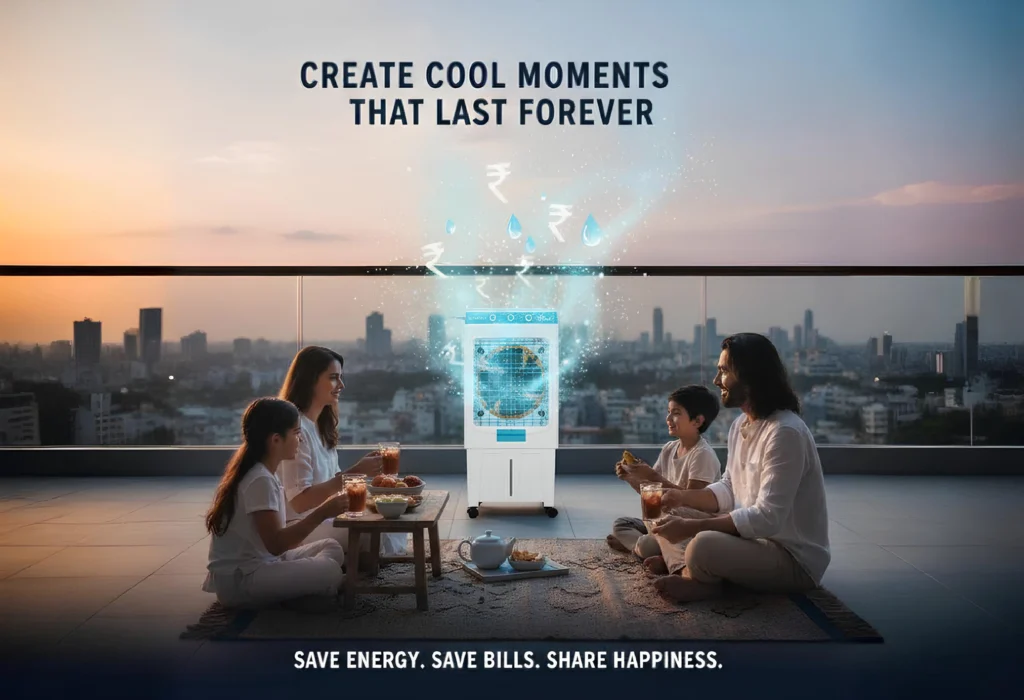Placing an air cooler near a window or open door allows it to pull in fresh, dry air for better cooling, while proper cross-ventilation ensures hot air escapes and cool air circulates freely. Pre-soaking the cooling pads by running the pump before turning on the fan helps achieve faster, more efficient cooling. Regular cleaning of the water tank, pads, and filters prevents dust buildup that can block airflow and increase electricity consumption. On extremely hot days, using chilled water or ice in the tank enhances the cooling experience. Choosing a cooler that matches the room size, running it at moderate speed once the room is comfortably cool, and switching it off when not in use are simple yet effective steps to enjoy maximum comfort while reducing power bills.
Why Efficient Cooling Matters
With electricity prices rising every year, managing cooling expenses has become a priority for many households. Even though air coolers naturally consume less power than ACs, improper use can still result in higher bills and sub-par cooling. By using your cooler efficiently, you can not only maintain a pleasant indoor environment but also reduce your carbon footprint and save a considerable amount on electricity costs.
How Air Coolers Work: A Quick Recap
Air coolers operate on the simple principle of evaporative cooling. They draw in warm air from the surroundings and pass it through water-soaked cooling pads. As the hot air comes in contact with water, it cools down through evaporation and is then circulated into the room using a fan. Unlike air conditioners, coolers do not rely on compressors or harmful refrigerants, which makes them far more energy-efficient and environmentally friendly.
An average desert cooler consumes only 150 to 300 watts per hour, whereas a split air conditioner consumes anywhere between 1500 to 2000 watts per hour. This means you can save up to 80% on electricity consumption simply by using an air cooler instead of an AC. In addition, coolers add moisture to the air, which is beneficial in dry climates, making the environment more comfortable and natural.
Tips to Use Air Cooler Effectively
1. Place the Cooler in the Right Spot
To maximize the performance of your air cooler, proper placement is very important. Always position the cooler near an open window or doorway to allow for a continuous supply of fresh air. Avoid placing it in closed corners where airflow is blocked, as this will reduce its cooling efficiency. Elevating the cooler slightly above the ground also helps distribute cool air more evenly throughout the room.
2. Ensure Proper Ventilation
Unlike ACs, which require airtight rooms, coolers work best with proper air circulation. Keeping windows slightly open allows hot air to escape and fresh air to enter, preventing humidity from building up inside the room. Without proper ventilation, the room may become damp and uncomfortable, reducing the cooling effect.
3. Pre-Cool the Cooling Pads
For faster and better cooling, it’s a good idea to pre-cool the cooling pads before switching on the fan. You can do this by filling the water tank and running the water pump for a few minutes to ensure the pads are fully soaked. This step prevents warm air from circulating at the start and boosts the overall cooling effect.
4. Clean and Maintain Regularly
Regular cleaning and maintenance play a major role in efficient cooling. Over time, dust and mineral deposits can accumulate on the cooling pads, filters, and water tank, which reduces airflow and overall performance. Cleaning these components at least once a week during peak summer ensures your cooler runs smoothly. Worn-out pads should be replaced every six to twelve months for consistent results.
5. Use Ice or Cold Water for Extra Cooling
For an extra cooling boost, you can add ice cubes or chilled water to the water tank. Many modern coolers even come with dedicated ice chambers for this purpose. However, be careful not to overfill the tank, as excess water may lead to leakage or malfunction.
6. Choose the Right Cooler Size for Your Room
It’s crucial to select a cooler that matches your room size. A small cooler in a large hall will struggle to cool the space, while an oversized cooler will waste energy. For small rooms up to 150 square feet, a 20–30 liter cooler is ideal. For medium-sized rooms, go for a 30–50 liter model, and for larger areas, opt for a 50 liter or higher capacity cooler for the best performance.
7. Adjust Fan Speed Smartly
Avoid running your cooler at maximum speed constantly. Start with high speed to cool the room quickly, and then lower it to medium or low once the temperature is comfortable. This simple practice helps save electricity and also ensures quieter, more efficient operation.
How to Save Electricity While Using an Air Cooler
Choosing the right model is the first step towards saving electricity. Modern air coolers with BLDC motors consume up to 60% less power than traditional motors while delivering superior performance. If you’re looking to buy a new cooler, check its wattage and energy efficiency rating before making a purchase.
Avoid running the cooler continuously when it’s not necessary. For example, if the room has already reached a comfortable temperature, you can switch it off for a while and turn it back on later. This interval-based operation helps reduce power consumption significantly.
Maintaining the water level is equally important for efficient cooling. If the water level is too low, the cooling pads will dry out, forcing the fan to circulate warm air. This makes the cooler work harder and consume more electricity. Always ensure the tank is filled with clean water to prevent clogging and bad odor.
If your cooler has a timer function, make full use of it, especially at night. Setting a timer will automatically turn off the cooler after a certain period, ensuring you don’t waste electricity while sleeping. Also, remember to switch off the cooler when leaving the room, as running it in an empty space only leads to unnecessary energy waste.
Air Cooler vs. Air Conditioner: Electricity Comparison
When it comes to energy consumption, the difference between an air cooler and an AC is huge. A typical air cooler uses just 150–300 watts per hour, while an AC requires 1500–2000 watts per hour. This means that running a cooler for eight hours a day may cost you only ₹400–₹600 per month, whereas an AC could easily add ₹2500–₹4000 to your bill. Coolers are also cheaper to purchase and maintain, and they use water instead of harmful refrigerants, making them eco-friendly and sustainable for long-term use. Switching to a high-quality cooler can save up to 70–80% on electricity costs compared to an air conditioner.
Conclusion
Using an air cooler effectively isn’t just about staying cool, it’s about cooling smartly. By following the right practices, such as proper placement, ensuring ventilation, maintaining water levels, and cleaning regularly, you can greatly improve the cooling performance of your unit. Pairing these habits with electricity-saving strategies like choosing energy-efficient models, using timers, and avoiding unnecessary operation will help you enjoy a comfortable summer while keeping your bills under control.
Smart usage leads to better cooling, lower costs, and a reduced environmental impact. Make these small changes today to enjoy a cool, refreshing, and budget-friendly summer.

